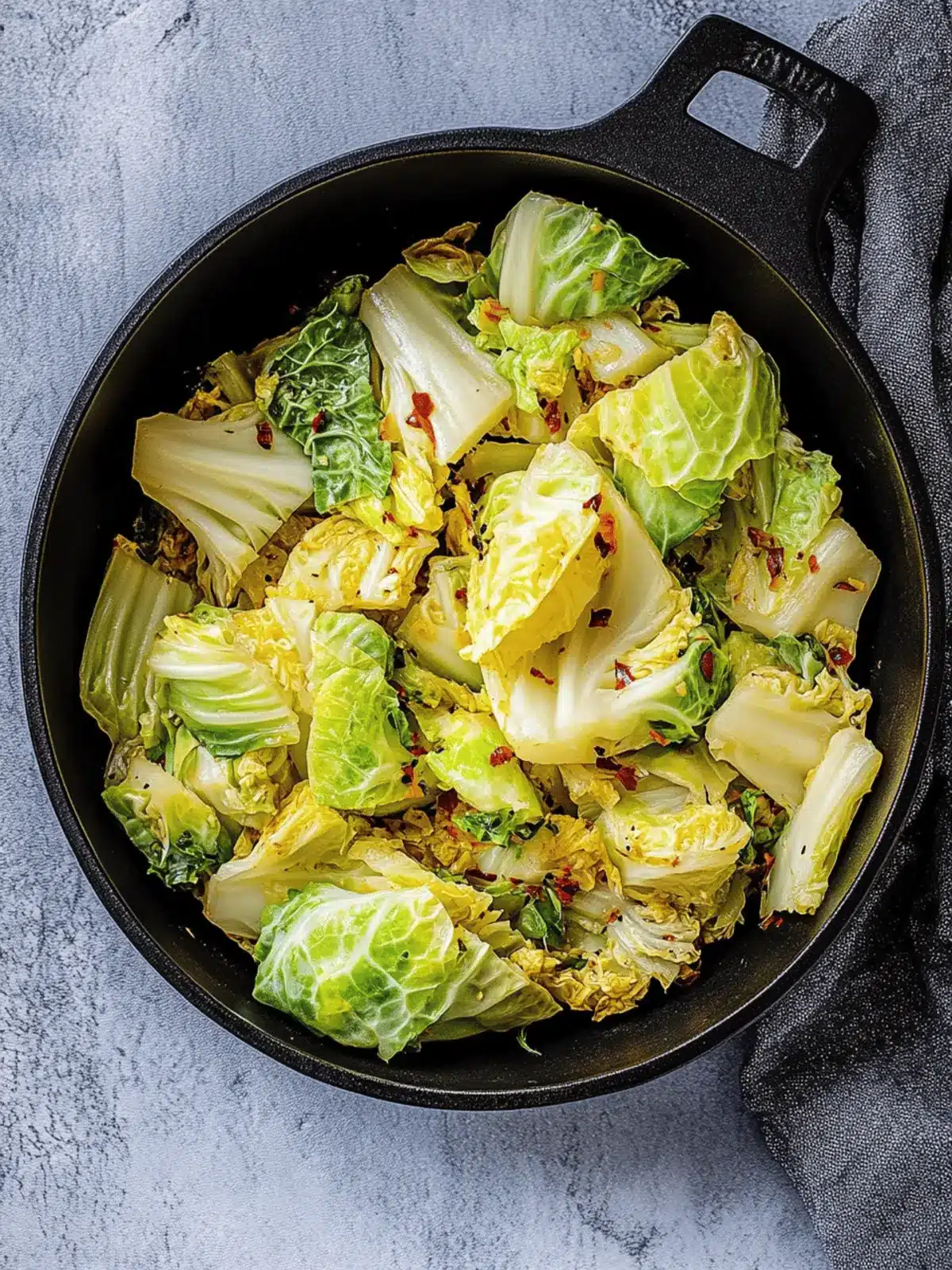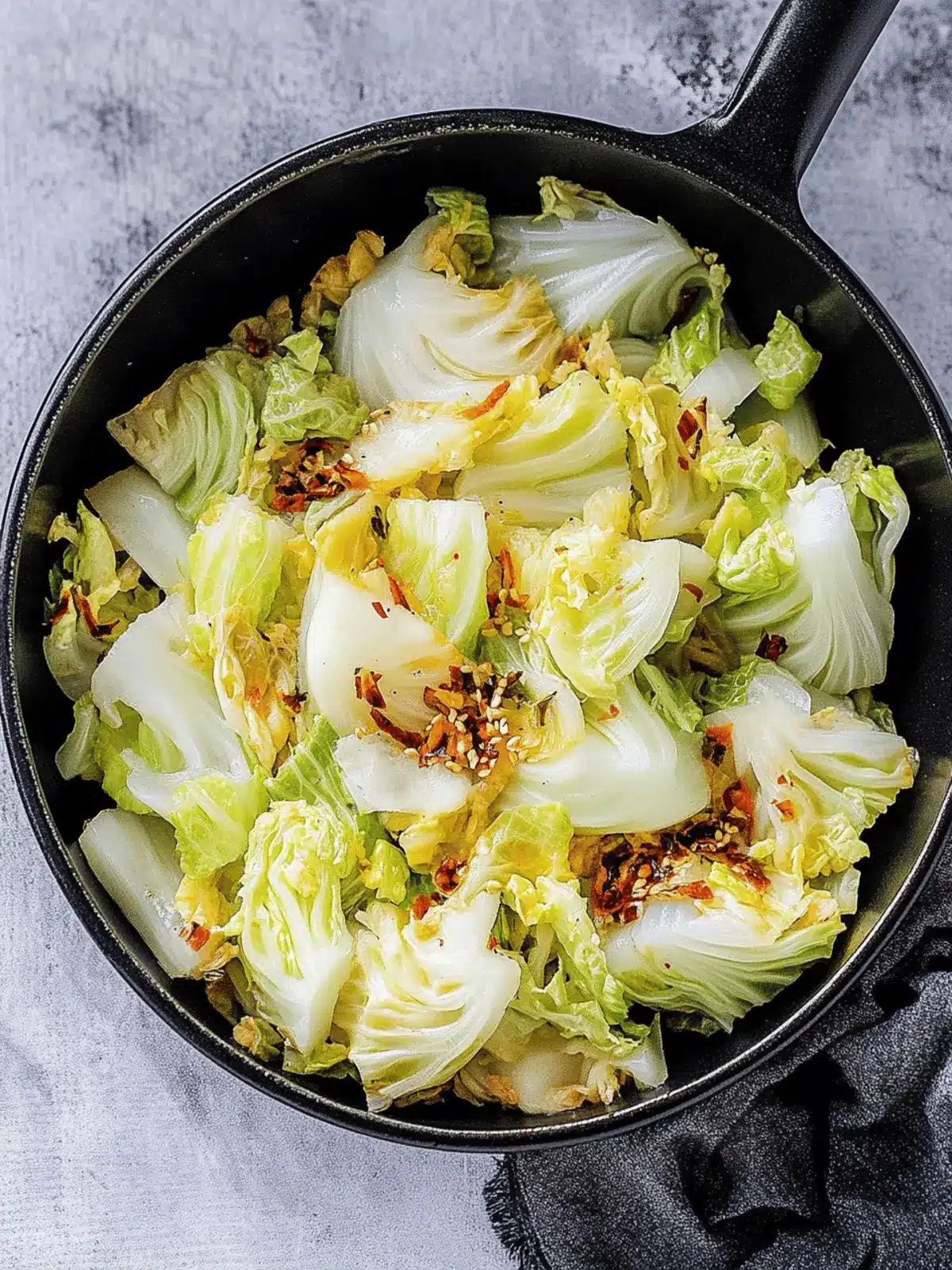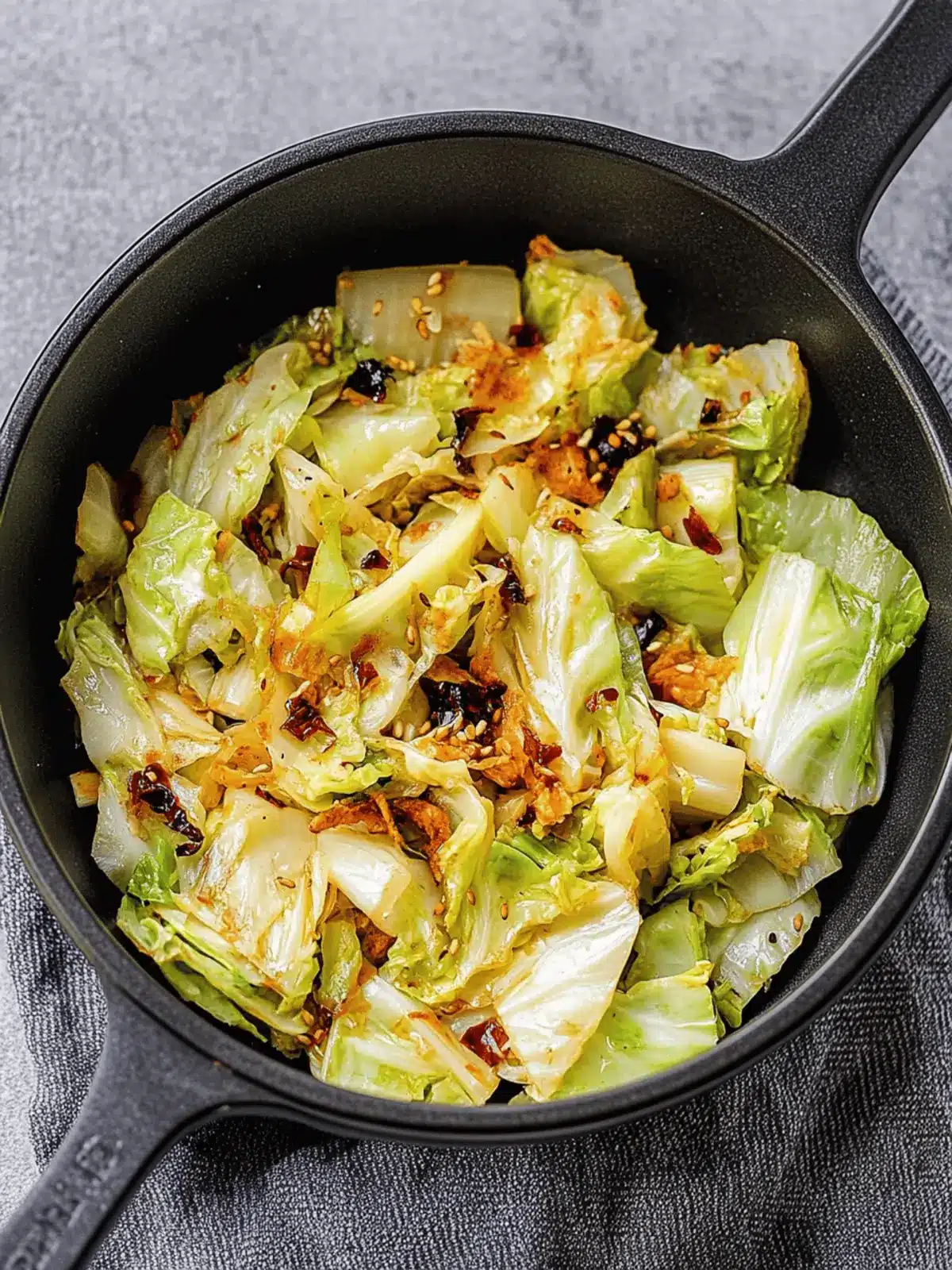There’s something incredibly satisfying about a dish that comes together in just 10 minutes, especially on those busy weeknights when cooking feels more like a chore than a pleasure. Enter my Quick and Easy Japanese Cabbage with Soy & Mirin! With the sweet notes of mirin and the savory depth of soy sauce mingling with fragrant garlic, this quick side dish transforms simple cabbage into a delightful experience that feels both comforting and energizing.
Inspired by traditional Japanese home cooking, this recipe packs a flavorful punch while keeping things effortless and adaptable. Whether you’re a seasoned chef or someone just looking to escape fast food monotony, this dish can easily side alongside any Asian-inspired meal or shine as a light main attraction. Plus, with gluten-free options available, it invites everyone to the table. So, let’s dive into this culinary delight that’s sure to become a new favorite in your home!
Why is Japanese Cabbage with Soy & Mirin a must-try?
Quick Preparation: This dish comes together in just 10 minutes, making it an ideal choice for busy weeknights when you need a fast, satisfying meal.
Bursting with Flavor: A harmonious blend of sweet mirin and savory soy sauce, complemented by aromatic garlic, creates an irresistible taste that’s both comforting and uplifting.
Versatile Side Dish: Perfect alongside grilled meats, tofu, or as a topping for ramen, it seamlessly fits into any Asian-inspired meal or can be enjoyed on its own.
Healthy Addition: With about 81 calories per serving, this low-calorie option is packed with crunchy cabbage and vibrant flavors that won’t weigh you down.
Easily Customizable: Substitute ingredients like tamari for a gluten-free version or add other veggies for extra nutrition, ensuring it can adapt to your pantry.
Crowd-Pleasing: This dish appeals to everyone, whether they are seasoned foodies or just looking for a delicious escape from fast food chaos!
Japanese Cabbage with Soy & Mirin Ingredients
For the Cabbage
• Cabbage – The base of the dish; use large white cabbage shredded thinly for the best texture.
• Olive Oil – Ideal for sautéing; it adds richness while cooking the cabbage beautifully.
For the Flavor
• Garlic – Finely chopped for an aromatic touch; it enhances the overall flavor profile.
• Soy Sauce – A crucial savory component; substitute with tamari for a gluten-free option.
• Mirin – Adds a sweet, umami flavor; if unavailable, mix water with a bit of honey as an alternative.
• Sesame Oil – This finishing touch enhances richness; don’t skip it for a balanced taste.
Optional Spices and Garnish
• Chili Crisp Oil – Adds delightful spice and crunch for those craving a kick.
• Chives/Green Onions – Perfect for garnish; they bring a pop of color and fresh onion flavor to the dish.
How to Make Japanese Cabbage with Soy & Mirin
-
Heat Oil: In a large skillet, warm olive oil over high heat. This will help create a beautiful sauté for the cabbage, enhancing its flavor.
-
Sauté Garlic: Add finely chopped garlic to the skillet. Cook for about 10-15 seconds until it’s fragrant, being careful not to let it burn.
-
Add Cabbage: Toss in the shredded cabbage and sprinkle with a pinch of salt. Let it sit for 30 seconds to achieve an initial sear that brings out the cabbage’s natural sweetness.
-
Cook Until Tender: Stir the cabbage, then reduce the heat to medium-high. Sauté for approximately 2 minutes, stirring often, until it softens yet remains slightly crispy.
-
Mix in Sauces: Pour the soy sauce, mirin, and sesame oil into the pan. Stir well and continue to cook for an additional minute, allowing the flavors to meld beautifully.
-
Serve and Enjoy: Plate the cabbage and top it with optional chili crisp and chopped chives for added crunch and color, bringing the dish to life!
Optional: Drizzle extra sesame oil for a richer flavor profile.
Exact quantities are listed in the recipe card below.
Japanese Cabbage with Soy & Mirin Variations
Feel free to shake things up and make this dish your own with these delightful twists!
- Gluten-Free: Substitute regular soy sauce with tamari to keep this dish celiac-friendly without losing any flavor. Enjoy the same delicious umami notes!
- Extra Veggies: Toss in sliced mushrooms or shredded carrots for added nutrition and textures that add variety to each bite. The more colorful, the better!
- Sweetener Swap: Replace mirin with a mixture of water and honey for a similar sweetness. It’s a perfect option if you’re out of mirin!
- Spicy Kick: Drizzle chili crisp oil over the top for a satisfying heat and additional crunch that makes each forkful exciting. Spice enthusiasts will love this fiery enhancement!
- Herb Infusion: Incorporate fresh herbs like cilantro or basil for a refreshing contrast to the savory cabbage. They add brightness and enhance the dish beautifully!
- Protein Addition: Top with sautéed tofu, a poached egg, or leftover grilled chicken to turn this side into a filling vegetarian main dish. Your taste buds will rejoice!
- Nuts for Crunch: Sprinkle toasted sesame seeds or crushed peanuts on top for an irresistible crunch that contrasts with the tender cabbage. This simple addition elevates the dish!
- Zesty Flavor: Add a splash of lime or lemon juice before serving for a tangy finish that brightens the whole dish and balances the savory notes perfectly.
Enjoy exploring these variations and let your culinary creativity shine!
How to Store and Freeze Japanese Cabbage with Soy & Mirin
Fridge: Store leftover Japanese Cabbage with Soy & Mirin in an airtight container for up to 2-3 days to keep freshness and flavor intact.
Freezer: While not ideal for freezing due to texture changes, you can freeze for up to 1 month if necessary; just place in a freezer-safe container.
Reheating: When ready to enjoy, reheat in a skillet over medium heat, adding a splash of water to revive moisture, or microwave in short intervals until heated through.
Serving Again: It’s best enjoyed fresh, so try to consume your leftovers quickly for optimal taste and texture!
Expert Tips for Japanese Cabbage with Soy & Mirin
-
Pan Size Matters: Avoid overcrowding the pan, as this can lead to steaming instead of sautéing, preventing that delicious browning.
-
Prep Ahead: Chopping garlic and shredding cabbage in advance can save you time, allowing for a quick, hassle-free cooking experience.
-
Protein Boost: To enhance the nutritional value of your Japanese Cabbage with Soy & Mirin, consider adding sautéed tofu, a poached egg, or leftover chicken on top.
-
Storage Tips: Keep leftovers fresh for 2-3 days in the refrigerator. To maintain texture, reheat gently and add a splash of water if needed.
-
Flavor Enhancements: Don’t hesitate to experiment by adding other vegetables like mushrooms or carrots for extra nutrition and flavor depth!
What to Serve with Japanese Cabbage with Soy & Mirin?
Imagine the vibrant colors and flavors that can turn an ordinary meal into an extraordinary dining experience.
- Grilled Chicken Teriyaki: The rich and sweet sauce contrasts beautifully with the crisp, savory cabbage, creating a wonderful balance of flavors.
- Steamed Jasmine Rice: Fluffy, fragrant rice serves as a perfect canvas to soak up the delicious soy and mirin sauce, enhancing each bite.
- Miso Soup: A warm, comforting companion; the earthy umami flavors complement the cabbage, offering depth and warmth to your meal.
- Pan-Seared Tofu: This vegetarian option adds protein and a lovely texture, making for a satisfying meal that’s both hearty and healthy.
- Sautéed Green Beans: Crisp-tender and lightly seasoned, these provide a refreshing crunch to contrast with the soft cabbage texture.
- Chilled Sake: This traditional drink enhances the meal experience, with its lightness and subtle flavors mirroring the umami of the cabbage.
- Sesame Noodles: Richly flavored with sesame oil and a hint of spice, they bring a playful twist that pairs delightfully with your cabbage dish.
- Pineapple Sorbet: A bright, refreshing dessert that cleanses the palate after the umami-rich flavors, completing the meal on a sweet note.
- Cucumber Salad: Crisp and refreshing, this salad adds a cool crunch that complements the savory notes, enhancing your dining experience.
Make Ahead Options
Preparing your Japanese Cabbage with Soy & Mirin in advance is a brilliant way to save time on busy weeknights! You can chop the cabbage and garlic up to 24 hours ahead, keeping them in airtight containers in the refrigerator to maintain their freshness. Additionally, you can mix the soy sauce, mirin, and sesame oil together for easy access when you’re ready to cook. When you’re set to serve, simply heat the olive oil, sauté the garlic, and toss in your prepped cabbage along with the sauce mixture, cooking just until tender—this way, you’ll enjoy a delicious dish in no time, just as if it were freshly made!
Japanese Cabbage with Soy & Mirin Recipe FAQs
What type of cabbage should I use?
For this recipe, I recommend using large white cabbage shredded thinly. It provides the best texture and flavor for the dish, allowing the cabbage to become tender while still retaining some crunch.
How should I store leftovers?
To keep your Japanese Cabbage with Soy & Mirin fresh, store it in an airtight container in the refrigerator for up to 2-3 days. This will help maintain its vibrant flavors and texture, ensuring your leftovers are still enjoyable!
Can I freeze this dish?
While freezing is possible, I don’t recommend it due to potential texture changes. If you need to freeze, place the cabbage in a freezer-safe container and store for up to 1 month. To reheat, simply thaw in the refrigerator overnight and warm it gently on the stove with a splash of water for moisture.
What if my cabbage turns mushy?
If your cabbage becomes mushy, likely, it was cooked too long or the pan was overcrowded. For the best results, keep the heat high and avoid stirring too frequently. Aim for about 2 minutes of sautéing for tender yet crisp cabbage.
Is this dish suitable for gluten-free diets?
Absolutely! Just substitute soy sauce with tamari, which is gluten-free. This allows those with gluten sensitivities to enjoy the delicious flavors of Japanese Cabbage with Soy & Mirin without worry.
Can I add more vegetables to this dish?
Very! Feel free to incorporate other veggies like mushrooms, shredded carrots, or bell peppers for a colorful and nutritious twist. Just sauté them along with the cabbage for an extra pop of flavor and nutrients!

Savory Japanese Cabbage with Soy & Mirin in Just 10 Minutes
Ingredients
Equipment
Method
- In a large skillet, warm olive oil over high heat.
- Add finely chopped garlic to the skillet and cook for 10-15 seconds until fragrant.
- Toss in the shredded cabbage and sprinkle with a pinch of salt.
- Let it sit for 30 seconds for an initial sear.
- Stir the cabbage and reduce heat to medium-high. Sauté for about 2 minutes until slightly crispy.
- Pour in soy sauce, mirin, and sesame oil; stir well and cook for another minute.
- Plate and top with optional chili crisp and chopped chives.








